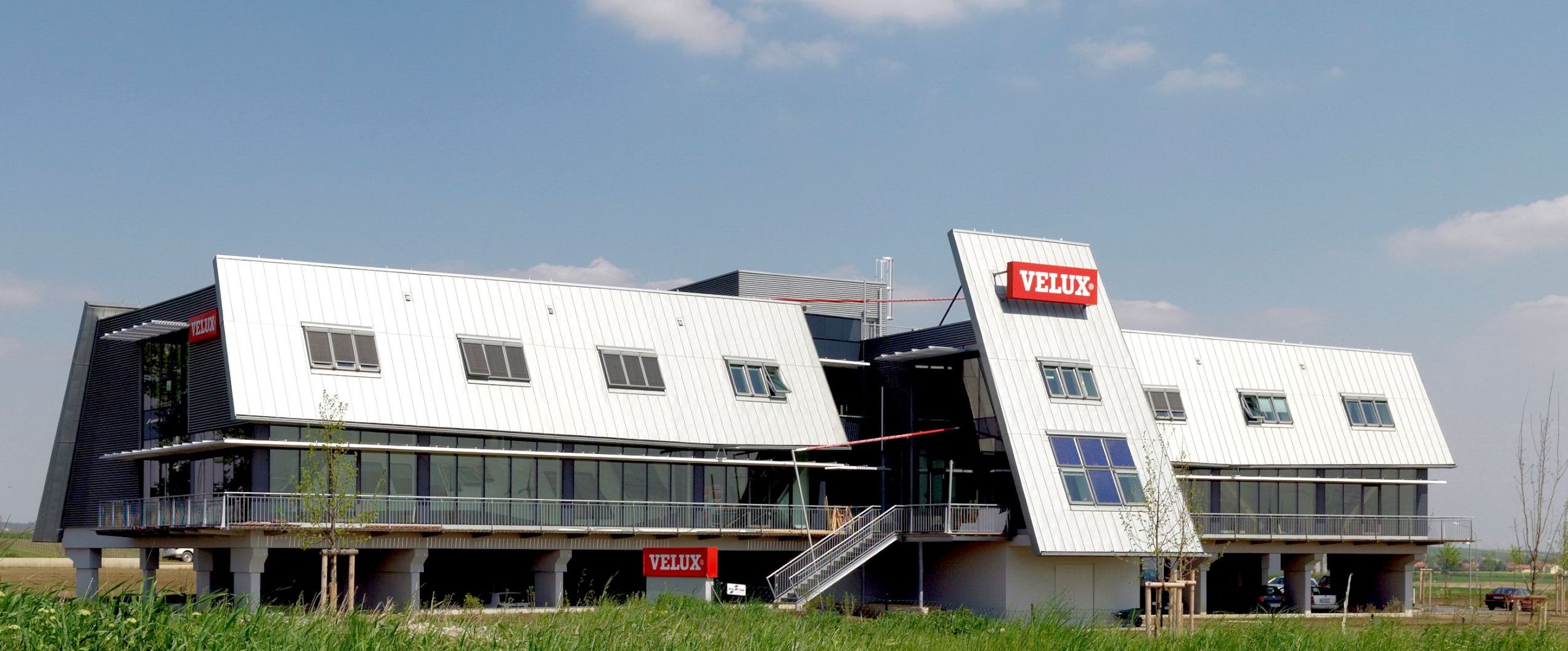
Thermal bridging solution for new Velux HQ building in Austria
CASE STUDY Schöck Isokorb for new Velux Headquarters
Schöck Isokorb proves ideal for Velux Headquarters
The industrial landscape leading out through the north eastern outskirts of Vienna is, perhaps surprisingly, a seemingly endless accumulation of dull unimaginative commercial buildings.
Endless that is until you reach Wolkersdorf, some twelve miles away, where attention is drawn immediately to the Austrian Headquarters of Velux, the major Danish window and skylight company.
Velux has been on this site for some 30 years and inevitably the original building had seen a number of modifications over that period.
So the decision was taken to develop a completely new administrative facility, much more in keeping with the contemporary style of the company.
HQ design by architect Werner Zita
Designed by architect Werner Zita, it is a building in stark contrast to what has gone before and draws on the local ambition to introduce more modern architectural styles to this otherwise traditional wine district area of Lower Austria.
The unusual sloping roofs stand out immediately, and as Zita explains: The linear layout of the building does not conform to any conventional right angles and is an attempt to reflect the undulating local landscape.
Built on two levels, with 1750m2 of usable area, the new headquarters incorporates offices, showrooms and training rooms, with a car park underneath the structure.
Critical to the design of the building is the Velux core concept of bringing fresh air and daylight into living and working spaces; so natural light floods into the building at every opportunity, helping to create a hospitable and friendly environment.
Preventing thermal bridging was a challenge
The façade and roof are made from a titanium zinc outer shell and the varying textures are achieved through the use of longitudinal sectioning. An angled standing seam technique is used in the steep roof areas, with a horizontal open slat facade in the entrance areas and on vertical surfaces.
Balconies are widely incorporated around the perimeter of the new Velux building and the prevention of thermal bridging was an early design consideration. It is critical because the resultant heat and energy loss are only two of the consequences if thermal bridging should occur.
Condensation and mould growth can develop as well, which may lead to potential health and respiratory problems for the occupants. So with balconies around the building connected to the edge of the internal reinforced concrete slab, preventing the possibility of thermal bridging at these connectivity points is crucial.
As a result, the designers of the Velux building incorporated one of the most effective countermeasures on the market, the Isokorb structural thermal break unit from Schöck. It is a range that allows connections to be made between concrete-to-concrete, concrete-to-steel and steel-to-steel.
The many different unit types available, combined with their ability to enable the transmission of shear, bending moment, tension and compression forces, also means that the options available effectively run into thousands when the different combinations are taken into account.
Concrete-to-steel balcony connectivity
For this particular application the Isokorb type KS from Schöck was the ideal solution. It is a concrete-to-steel connectivity module that sits between the outer and inner structural connection points and blocks the outflow of heat through the use of high quality polystyrene insulation foam.
This polystyrene core sits inside a compression module that has stainless steel bars passing through it and these in turn take the tension and shear forces between the building frame and the balconies.
The Isokorb enabled a thermally insulated, load bearing connection to be made between reinforced concrete and steel construction components, and at the same time provides a clean and unobtrusive connection detail.
Schock
The Clock Tower
2-4 High Street
Kidlington
OX5 2DH
UK
Phone
0845 241 3390
Fax
0845 241 3391
Visit Supplier's page
Latest news

21st February 2025
ASSA ABLOY EMEIA: Save valuable time and money with a seamless switch to programmable digital keys
In 2025, access management can be a whole lot easier. By making access part of their digital processes, businesses can put time-consuming key management and the cost of changing the locks firmly behind them. Making this switch is a lot easier than many people think, as ASSA ABLOY explains here…
Posted in Access Control & Door Entry Systems, Architectural Ironmongery, Articles, Building Industry News, Building Products & Structures, Building Services, Doors, Facility Management & Building Services, Health & Safety, Information Technology, Innovations & New Products, Retrofit & Renovation, Security and Fire Protection
21st February 2025
Showersave supports industry leaders in addressing Part L and Part G regulations
Showersave has sponsored and participated in a recent Building Insights LIVE roundtable on ‘Water & Energy Saving Innovations in New Build Housing’.
Posted in Articles, Bathrooms & Toilets, Bathrooms, Bedrooms & Washrooms, Building Associations & Institutes, Building Industry Events, Building Industry News, Building Products & Structures, Building Regulations & Accreditations, Building Services, Exhibitions and Conferences, Interiors, Pipes & Fittings, Plumbing, Retrofit & Renovation, Sustainability & Energy Efficiency
21st February 2025
GEZE: The importance of Specifying High Quality Door Closers on Fire Doors
Andy Howland, Sales & Marketing Director at GEZE UK, discusses why specifying high quality door closers on fire doors is important…
Posted in Access Control & Door Entry Systems, Accessibility, Architectural Ironmongery, Articles, Building Industry News, Building Products & Structures, Building Regulations & Accreditations, Building Services, Doors, Facility Management & Building Services, Health & Safety, Posts, Restoration & Refurbishment, Retrofit & Renovation, Security and Fire Protection
21st February 2025
Insight Data achieves ISO9001 recertification with zero non-conformities
Leading industry data specialist, Insight Data, has successfully achieved the prestigious recertification for ISO9001 with zero non-conformities for the fourth consecutive year.
Posted in Articles, Building Industry News, Building Regulations & Accreditations, Building Services, Information Technology, Research & Materials Testing
 Sign up:
Sign up: